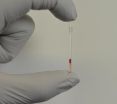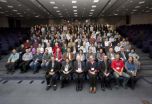(Press-News.org) CAMBRIDGE, Mass-- Cellphone apps that find users car rides in real time are exploding in popularity: The car-service company Uber was recently valued at $18 billion, and even as it faces legal wrangles, a number of companies that provide similar services with licensed taxi cabs have sprung up.
What if the taxi-service app on your cellphone had a button on it that let you indicate that you were willing to share a ride with another passenger? How drastically could cab-sharing reduce traffic, fares, and carbon dioxide emissions?
Authoritatively answering that question requires analyzing huge volumes of data, which hasn't been computationally feasible with traditional methods. But in today's issue of the Proceedings of the National Academies of Sciences, researchers at MIT, Cornell University, and the Italian National Research Council's Institute for Informatics and Telematics present a new technique that enabled them to exhaustively analyze 150 million trip records collected from more than 13,000 New York City cabs over the course of a year.
Their conclusions: If passengers had been willing to tolerate no more than five minutes in delays per trip, almost 95 percent of the trips could have been shared. The optimal combination of trips would have reduced total travel time by 40 percent, with corresponding reductions in operational costs and carbon dioxide emissions.
"Of course, nobody should ever be forced to share a vehicle," says Carlo Ratti, professor of the practice in MIT's Department of Urban Studies and Planning (DUSP) and one of the paper's coauthors. "However, our research shows what would happen if people have sharing as an option. This is more than a theoretical exercise, with services such as Uber Pool bringing these ideas into practice."
Finding the optimal combination of trips does require foreknowledge of trips' starting times: For instance, a 30-minute trip the length of Manhattan might be combined with a 10-minute trip beginning 15 minutes later. But that kind of advance planning is unlikely if the passengers are using cellphone apps. So the researchers also analyzed the data on the assumption that only trips starting within a minute of each other could be combined. Even then, they still found a 32 percent reduction in total travel time.
"We think that with the potential of a 30 percent reduction in operational costs, there is plenty of room for redistributing these benefits to customers, because we have to offer them lower fares; to drivers, because we have to incentivize them to belong to this system; to companies; and of course, there is a benefit for the community," says Paolo Santi, a visiting scientist in DUSP and first author on the paper.
In fact, Santi says, the results of his and his colleagues' analysis were so striking that they asked Cornell mathematician Steven Strogatz to review their methodology. Strogatz is a co-author on the paper, as are Ratti and postdoc Stanislav Sobolevsky, both of MIT's Senseable City Lab. Rounding out the author list are Michael Szell, who was a postdoc in the Senseable City lab when the work was done and is now at Northeastern University, and Giovanni Resta, a researcher at Santi's home institution, the Institute for Informatics and Telematics.
In analyzing taxi data for ride-sharing opportunities, "Typically, the approach that was taken was a variation of the so-called 'traveling-salesman problem,'" Santi explains. "This is the basic algorithmic framework, and then there are extensions for sharing."
The traveling-salesman problem asks whether, given a set of cities and the travel times between them, there is a route that would allow a traveling salesman to reach all of them within some time limit. Unfortunately, the traveling-salesman problem is also an example — indeed, perhaps the most famous example — of an NP-complete problem, meaning that even for moderate-sized data sets, it can't (as far as anyone knows) be solved in a reasonable amount of time.
So Santi and his colleagues took a different approach. First, they characterize every taxi trip according to four measurements: the time and GPS coordinates of both the pickup and the dropoff. Then, for each trip, their algorithm identifies the set of other trips that overlap with it — the ones that begin before it ends. Then it determines whether the trip they're examining can be combined with any of those other trips without exceeding the delay threshold. On average, any given trip is "shareable" with about 100 other trips.
Next, the algorithm represents the shareability of all 150 million trips in the database as a graph. A graph is a mathematical abstraction consisting of nodes — usually depicted as circles — and edges — usually depicted as lines between nodes. In this case, the nodes represent trips and the edges represent their shareability.
The graphical representation itself was the key to the researchers' analysis. With that in hand, well-known algorithms can efficiently find the optimal matchings to either maximize sharing or minimize travel time.
The researchers also conducted experiments to ensure that their matching algorithm would work in real time, if it ran on a server used to coordinate data from cellphones running a taxi-sharing app. They found that, even running on a single Linux box, it could find optimal matchings for about 100,000 trips in a tenth of a second, whereas the GPS data indicated that on average, about 300 new taxi trips were initiated in New York every minute.
Finally, an online application designed by Szell, HubCab, allows people to explore the taxi data themselves, using a map of New York as an interface.
INFORMATION:
Written by Larry Hardesty, MIT News Office
Ride-sharing could cut cabs' road time by 30 percent
A new analytic framework enables analysis of GPS data on 150 million cab rides in New York City
2014-09-01
ELSE PRESS RELEASES FROM THIS DATE:
Faster, cheaper tests for sickle cell
2014-09-01
Within minutes after birth, every child in the U.S. undergoes a battery of tests designed to diagnose a host of conditions, including sickle cell disease. Thousands of children born in the developing world, however, aren't so lucky, meaning many suffer and die from the disease each year.
A.J. Kumar hopes to put a halt to at least some of those deaths.
A Post-Doctoral Fellow in Chemistry and Chemical Biology working in the lab of George Whitesides, the Woodford L. and Ann A. Flowers University Professor, Kumar and colleagues, including other co-authors, have developed ...
Training your brain to prefer healthy foods
2014-09-01
BOSTON (September 1, 2014, 10:20 AM EDT) — It may be possible to train the brain to prefer healthy low-calorie foods over unhealthy higher-calorie foods, according to new research by scientists at the Jean Mayer USDA Human Nutrition Research Center on Aging (USDA HNRCA) at Tufts University and at Massachusetts General Hospital. Published online today in the journal Nutrition & Diabetes, a brain scan study in adult men and women suggests that it is possible to reverse the addictive power of unhealthy food while also increasing preference for healthy foods.
"We don't start ...
Fruit consumption cuts CVD risk by up to 40 percent
2014-09-01
Barcelona, Spain – Monday 1 September 2014: Daily fruit consumption cuts the risk of cardiovascular disease (CVD) by up to 40%, according to research presented at ESC Congress today by Dr Huaidong Du from Oxford, UK. The findings from the seven year follow-up study of nearly 0.5 million people in the China Kadoorie Biobank found that the more fruit people ate, the more their risk of CVD declined.
Dr Du said: "CVD, including ischaemic heart disease (IHD) and stroke, is the leading cause of death worldwide. Improving diet and lifestyle is critical for CVD risk reduction ...
Permanent AF doubles risk of stroke compared to paroxysmal AF
2014-09-01
Barcelona, Spain – Monday 1 September 2014: Permanent atrial fibrillation (AF) doubles the risk of stroke compared to paroxysmal AF, according to research in more than 6 000 patients presented at ESC Congress today by Dr Thomas Vanassche from Belgium. The findings suggest that a simple clinical assessment of the type of AF can help doctors to better estimate stroke risk.
Ischaemic stroke is the second cause of death in the EU, accounting for over a million deaths and many more disabled patients each year. Annual direct health care costs amount to more than €20 billion. ...
A nucleotide change could initiate fragile X syndrome
2014-09-01
Researchers reveal how the alteration of a single nucleotide—the basic building block of DNA—could initiate fragile X syndrome, the most common inherited form of intellectual disability. The study appears in The Journal of Cell Biology.
Fragile X syndrome is caused by a defect in a gene on the X chromosome called fragile X mental retardation 1 (FMR1). Around 1 in 230 women and 1 in 360 men carry a so-called premutation, in which a series of DNA repeats at one end of the FMR1 gene is slightly longer than normal. These repeats are prone to even further expansion when ...
Scientists call for investigation of mysterious cloud-like collections in cells
2014-09-01
WASHINGTON — About 50 years ago, electron microscopy revealed the presence of tiny blob-like structures that form inside cells, move around and disappear. But scientists still don't know what they do — even though these shifting cloud-like collections of proteins are believed to be crucial to the life of a cell, and therefore could offer a new approach to disease treatment.
In the Journal of Cell Biology, two researchers are issuing a call to investigators from various backgrounds, from biophysics to cell biology, to focus their attention on the role of these formations— ...
Zooming in for a safe flight
2014-09-01
As nocturnal animals, bats are perfectly adapted to a life without light. They emit echolocation sounds and use the delay between the reflected echoes to measure distance to obstacles or prey. In their brains, they have a spatial map representing different echo delays. A study carried out by researchers at Technische Universität München (TUM) has shown for the first time that this map dynamically adapts to external factors.
Closer objects appear larger
When a bat flies in too close to an object, the number of activated neurons in its brain increases. As a result, ...
Week-long meeting on naming algae, fungi, and plants recorded for posterity
2014-09-01
The week-long discussions and decisions of the Nomenclature Section of the XVIII International Botanical Congress took place in Melbourne, Australia in July 2011. This meeting is held every six years and it is where the world's premier experts on the rules for naming algae, fungi and plants get together to debate and update the rule book for naming the organisms they study. This is the primary product of the meeting, the International Code of Nomenclature for algae, fungi, and plants, which was published in 2012. The other important product is the official report for the ...
Scientists get set for simulated nuclear inspection
2014-09-01
Some 40 scientists and technicians from around the world will descend on Jordan in November to take part in a simulated on-site inspection of a suspected nuclear test site on the banks of the Dead Sea.
Playing the part of inspectors, the experts will have access to a wide range of sensor technologies to look for signs of whether a nuclear explosion has taken place. At the same time, other role-players representing the state under inspection will try to put them off their scent.
The aim of this elaborate exercise, as science writer Edwin Cartlidge explains in this month's ...
Invisible blood in urine may indicate bladder cancer
2014-09-01
New research which finds that invisible blood in urine may be an early warning sign of bladder cancer is likely to shape guidelines for clinicians.
Scientists at the University of Exeter Medical School found that one in 60 people over the age of 60 who had invisible blood in their urine (identified by their GP testing their urine) transpired to have bladder cancer. The figure was around half those who had visible blood in their urine – the best known indicator of bladder cancer. However, it was still higher than figures for other potential symptoms of bladder cancer ...
LAST 30 PRESS RELEASES:
Eye for trouble: Automated counting for chromosome issues under the microscope
The vast majority of US rivers lack any protections from human activities, new research finds
Ultrasound-responsive in situ antigen "nanocatchers" open a new paradigm for personalized tumor immunotherapy
Environmental “superbugs” in our rivers and soils: new one health review warns of growing antimicrobial resistance crisis
Triple threat in greenhouse farming: how heavy metals, microplastics, and antibiotic resistance genes unite to challenge sustainable food production
Earthworms turn manure into a powerful tool against antibiotic resistance
AI turns water into an early warning network for hidden biological pollutants
Hidden hotspots on “green” plastics: biodegradable and conventional plastics shape very different antibiotic resistance risks in river microbiomes
Engineered biochar enzyme system clears toxic phenolic acids and restores pepper seed germination in continuous cropping soils
Retail therapy fail? Online shopping linked to stress, says study
How well-meaning allies can increase stress for marginalized people
Commercially viable biomanufacturing: designer yeast turns sugar into lucrative chemical 3-HP
Control valve discovered in gut’s plumbing system
George Mason University leads phase 2 clinical trial for pill to help maintain weight loss after GLP-1s
Hop to it: research from Shedd Aquarium tracks conch movement to set new conservation guidance
Weight loss drugs and bariatric surgery improve the body’s fat ‘balance:’ study
The Age of Fishes began with mass death
TB harnesses part of immune defense system to cause infection
Important new source of oxidation in the atmosphere found
A tug-of-war explains a decades-old question about how bacteria swim
Strengthened immune defense against cancer
Engineering the development of the pancreas
The Journal of Nuclear Medicine ahead-of-print tip sheet: Jan. 9, 2026
Mount Sinai researchers help create largest immune cell atlas of bone marrow in multiple myeloma patients
Why it is so hard to get started on an unpleasant task: Scientists identify a “motivation brake”
Body composition changes after bariatric surgery or treatment with GLP-1 receptor agonists
Targeted regulation of abortion providers laws and pregnancies conceived through fertility treatment
Press registration is now open for the 2026 ACMG Annual Clinical Genetics Meeting
Understanding sex-based differences and the role of bone morphogenetic protein signaling in Alzheimer’s disease
Breakthrough in thin-film electrolytes pushes solid oxide fuel cells forward
[Press-News.org] Ride-sharing could cut cabs' road time by 30 percentA new analytic framework enables analysis of GPS data on 150 million cab rides in New York City




